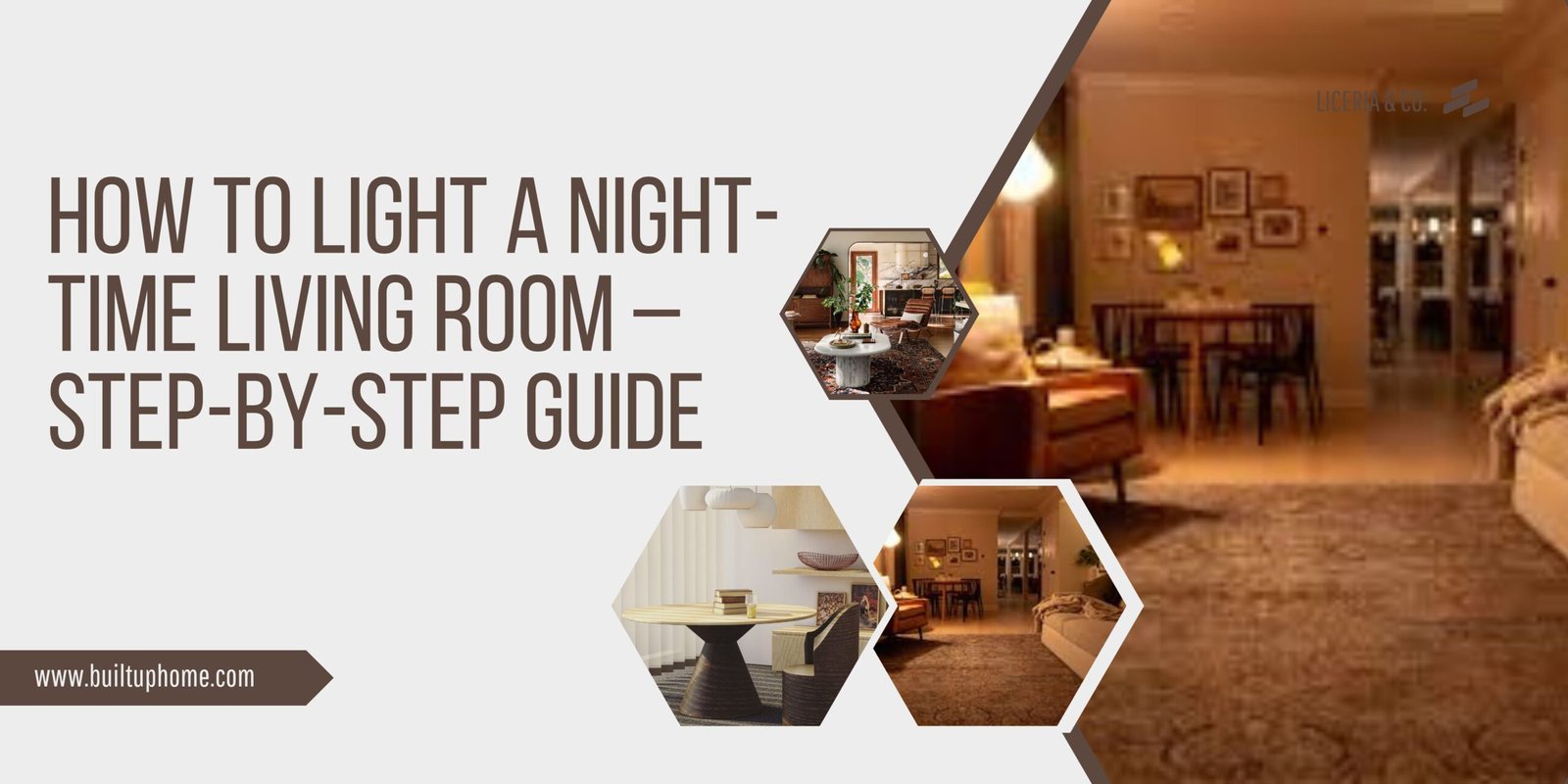Why Lighting Matters at Night
Lighting plays a crucial role in shaping how your living room feels at night. It’s not just about visibility—it’s about creating an atmosphere that reflects your lifestyle. Whether you want a cozy retreat or a space for late-night chats, thoughtful light can transform the room.
The Role of Lighting in Comfort and Mood
Light influences our mood, energy levels, and ability to relax. Harsh lights can make a space feel cold or overwhelming, while soft, warm light invites calm and comfort. Understanding this connection helps you design a living room that supports your night-time needs.
Overview of the Step-by-Step Process
In this guide, we’ll walk you through three essential steps to lighting your night-time living room effectively:
Step 1: Assess your space and lighting needs
Step 2: Choose the right types of lighting
Step 3: Set up and optimize your lighting setup
Assess Your Space and Lighting Needs
Understand the Purpose of Your Living Room at Night
The way you use your living room at night affects your lighting choices. Consider:
- Relaxation & Entertainment: You’ll want soft, ambient lighting for winding down.
- Reading or Hobbies: Focused task lighting is a must to avoid eye strain.
- Hosting Guests: A mix of light sources ensures a warm and inviting atmosphere.
Read more about: How to Position Pot Lights in a Living Room
Evaluate the Existing Lighting Setup
Take note of what you already have:
- Are there ceiling fixtures, floor lamps, or wall sconces?
- Where are the dark or poorly lit areas?
- How much natural light do you still get at dusk?
Make a list of what’s missing and where improvements are needed.
Determine the Desired Mood and Ambience
Do you prefer a warm, relaxing vibe or a more vibrant, functional space? This will guide your choice of brightness levels and bulb color temperatures. Consider layering your lighting—using multiple light sources at different levels—to create a flexible and cozy ambiance.
Choose the Right Types of Lighting
Ambient Lighting – Your Base Layer
Ambient light fills the room with overall illumination.
Options include:
- Ceiling Fixtures: Chandeliers, flush mounts, or pendant lights.
- Recessed Lighting: Ideal for low-ceiling or modern spaces.
- Smart Bulbs: Let you dim or change color temperature via app or voice.
Ambient light should provide general visibility without being overpowering.
Task Lighting – For Focused Activities
Task lighting targets specific areas for activities like reading, knitting, or working on a laptop.
- Floor Lamps: Perfect next to a reading chair or sofa.
- Desk Lamps: Adjustable arms help direct light where needed.
- Shelf or Cabinet Lighting: Useful for illuminating books or collections.
Choose fixtures that reduce eye strain and offer adjustable brightness.
Accent Lighting – Adding Depth and Style
Accent lighting adds dimension and draws attention to decor elements.
- Wall Sconces: Soft side lighting adds elegance and warmth.
- Picture Lights: Highlight artwork or gallery walls.
- LED Strips: Line them behind TVs or under furniture for subtle glow.
These lights help define zones and add personality to the space.
Decorative Lighting – Add Personality
Decorative light can be functional, but they also act as artistic element.
- String Lights: Drape across windows or walls for a whimsical touch.
- Statement Lamps: Add character with bold or artistic designs.
- Color-Changing LEDs: Great for creating themed moods or seasonal decor.
Don’t be afraid to have fun with your lighting choices here.
Set Up and Optimize Your Night-Time Lighting
Arrange Lights Based on Zones
Break your living room into functional zones and light them accordingly:
- Seating Area: Use a combination of floor lamps and side table lamps.
- Reading Nook: Place a bright but soft lamp directly over the chair or table.
- Media/TV Area: Use ambient light or backlighting to reduce eye strain from screens.
Layering different types of lights in each zone gives you flexibility.
Use Lighting Controls
Modern lighting is all about convenience and customization:
- Dimmer Switches: Allow smooth control over brightness levels.
- Smart Plugs/Timers: Automate lights to turn on or off at specific times.
- Voice Assistants: Control lights hands-free with Alexa, Google Assistant, or Siri.
These tools can make your lighting setup more energy-efficient and user-friendly.
Balance Warmth and Brightness
Night-time lighting should be warm and gentle on the eyes:
- Color Temperature: Stick to 2700K–3000K (soft white or warm white).
- Avoid Cool or Blue Light: It can disrupt melatonin production and sleep cycles.
- Mix Bulbs: Combine different brightness levels for visual interest.
A warm glow encourages relaxation and makes your space more inviting.
Eliminate Glare and Shadows
Proper light placement can make all the difference:
- Avoid Direct Glare: Use lampshades, dimmers, or directional lighting.
- Bounce Light: Angle lamps to reflect light off walls or ceilings.
- Soften Shadows: Use multiple light sources to reduce contrast.
This makes the room feel softer and more visually balanced.
Extra Tips for Perfect Night-Time Lighting
- Use Mirrors: They reflect light, making the room feel brighter and bigger.
- Incorporate Candles: Natural flickering light adds warmth and coziness.
- Go Energy-Efficient: Choose LED bulbs to reduce electricity use.
- Change with the Seasons: Use warmer tones in winter and lighter ones in summer.
These small details can make your lighting setup feel even more thoughtful.
Conclusion
Recap of the 3-Step Process
To recap:
- Step 1 helps you understand what you need
- Step 2 guides you in choosing the right light types
- Step 3 shows you how to put it all together effectively
The Impact of Thoughtful Night-Time Lighting
With the right setup, your living room becomes a soothing retreat after sunset—a space to relax, recharge, or enjoy good company.
Encouragement to Experiment and Personalize
Lighting isn’t one-size-fits-all. Feel free to experiment, move things around, and personalize your setup until it feels just right for you.

